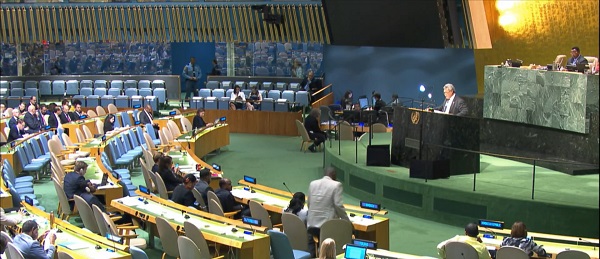Economy
Trump’s Promise Of American Abundance, Fueled By ‘Liquid Gold’

 From the Daily Caller News Foundation
From the Daily Caller News Foundation
One of the brightest nuggets of policy in Donald Trump’s July 18 acceptance speech to the Republican convention in Milwaukee was his ode to “liquid gold.” That is, oil.
As part of his inflation-fighting plan, Trump offered a gleaming solution: increase energy production, thereby decreasing energy prices. “By slashing energy costs,” Trump declared, “we will in turn reduce the cost of transportation, manufacturing and all household goods.”
He continued: “We have more liquid gold under our feet than any other country by far. We are a nation that has the opportunity to make an absolute fortune with its energy.”
Indeed. According to the Institute for Energy Research (IER) technically recoverable oil resources in the U.S. total 2.136 trillion barrels. At the current price of around $80 a barrel, that’s some $171 trillion. And so, Trump concluded, “we will reduce our debt, $36 trillion.”
As former Alaska governor Sarah Palin would say, “You betcha.” In Palin’s Alaska, oil is so abundant, relative to the population, that everyone gets a check from the state. Last year, it was $1,312. For a family of four, that’s more than $5000. Our goal should be that every American gets such an energy dividend.
Moreover, the abundance of America’s carbon fuels is not limited to oil. According to IER, we have 3.391 trillion cubic feet of natural gas. That’s worth $165 trillion.
To be sure, these staggering dollar totals can’t be counted directly against the national debt—or in support of some future tax cut. Yet every dollar of our energy assets would contribute to the economy, and if even 10 percent of the humongous total could be available to the public, we could, in fact, pay off the national debt.
Moreover, thanks to fracking and other enhanced recovery techniques, we keep finding more energy: Human ingenuity has upended old beliefs about energy shortages, ushering in an almost Moore’s Law-ish surge in production.
Indeed, there’s so much oil and gas (and coal) that an emerging school of thought holds that carbon fuels aren’t “fossil” at all, but rather, the product of earth’s vulcanism. The core of this earth, after all, is the same temperature as the surface of the sun. Perhaps all that heat is cooking something.
In any case, we keep finding more oil, and not just in the U.S.
So how, exactly, do we take advantage of this planetary cornucopia? As Palin said, as Trump said, and as the convention crowd chanted, “drill, baby, drill.”
Okay, but what about climate change? Most Republicans don’t worry too much about that, but if Democrats do, they should be reassured that we can capture the carbon and so take it out of the atmosphere. Trees and other green vegetation have been capturing carbon for eons; the element is, in fact, vital to their very existence. Similarly, the human body is 18 percent carbon. Yes, all of us ourselves are carbon sinks.
So we, being smart, can capture vastly more carbon — capturing it in everything from wood to cement, from plastics to nanotubes. These in turn can be landfill, construction materials — maybe even a space elevator.
We can, in fact, establish a a circular carbon economy: carbon fuels extracted, burned, and then recycled back into feedstocks. By this reckoning, carbon fuels are renewable. Such creative thinking can power all those energy-hungry data centers on which Big Tech and AI depend. So there’s the makings of a bipartisan “Grand Carbon Bargain,” uniting mostly blue-state tech with mostly red-state energy. More energy + more tech = more wealth for all.
In Milwaukee, Trump spoke of American “energy dominance,” and that’s great. But with all the energy we can produce and consume, we can speak of economic abundance — and that’s even greater.
James P. Pinkerton served in the White House domestic policy offices of Presidents Ronald Reagan and George H.W. Bush. He is the author, most recently, of “The Secret of Directional Investing: Making Money Amidst the Red-Blue Rumble.”
Business
Trump confirms 35% tariff on Canada, warns more could come

Quick Hit:
President Trump on Thursday confirmed a sweeping new 35% tariff on Canadian imports starting August 1, citing Canada’s failure to curb fentanyl trafficking and retaliatory trade actions.
Key Details:
- In a letter to Canadian Prime Minister Mark Carney, Trump said the new 35% levy is in response to Canada’s “financial retaliation” and its inability to stop fentanyl from reaching the U.S.
- Trump emphasized that Canadian businesses that relocate manufacturing to the U.S. will be exempt and promised expedited approvals for such moves.
- The administration has already notified 23 countries of impending tariffs following the expiration of a 90-day negotiation window under Trump’s “Liberation Day” trade policy.
Diving Deeper:
President Trump escalated his tariff strategy on Thursday, formally announcing a 35% duty on all Canadian imports effective August 1. The move follows what Trump described as a breakdown in trade cooperation and a failure by Canada to address its role in the U.S. fentanyl crisis.
“It is a Great Honor for me to send you this letter in that it demonstrates the strength and commitment of our Trading Relationship,” Trump wrote to Prime Minister Mark Carney. He added that the tariff response comes after Canada “financially retaliated” against the U.S. rather than working to resolve the flow of fentanyl across the northern border.
Trump’s letter made clear the tariff will apply broadly, separate from any existing sector-specific levies, and included a warning that “goods transshipped to evade this higher Tariff will be subject to that higher Tariff.” The president also hinted that further retaliation from Canada could push rates even higher.
However, Trump left the door open for possible revisions. “If Canada works with me to stop the flow of Fentanyl, we will, perhaps, consider an adjustment to this letter,” he said, adding that tariffs “may be modified, upward or downward, depending on our relationship.”
Canadian companies that move operations to the U.S. would be exempt, Trump said, noting his administration “will do everything possible to get approvals quickly, professionally, and routinely — In other words, in a matter of weeks.”
The U.S. traded over $762 billion in goods with Canada in 2024, with a trade deficit of $63.3 billion, a figure Trump called a “major threat” to both the economy and national security.
Speaking with NBC News on Thursday, Trump suggested even broader tariff hikes are coming, floating the idea of a 15% or 20% blanket rate on all imports. “We’re just going to say all of the remaining countries are going to pay,” he told Meet the Press moderator Kristen Welker, adding that “the tariffs have been very well-received” and noting that the stock market had hit new highs that day.
The Canadian announcement is part of a broader global tariff rollout. In recent days, Trump has notified at least 23 countries of new levies and revealed a separate 50% tariff on copper imports.
“Not everybody has to get a letter,” Trump said when asked if other leaders would be formally notified. “You know that. We’re just setting our tariffs.”
Business
UN’s ‘Plastics Treaty’ Sports A Junk Science Wrapper


From the Daily Caller News Foundation
By Craig Rucker
According to a study in Science Advances, over 90% of ocean plastic comes from just 10 rivers, eight of which are in Asia. The United States, by contrast, contributes less than 1%. Yet Pew treats all nations as equally responsible, promoting one-size-fits-all policies that fail to address the real source of the issue.
Just as people were beginning to breathe a sigh of relief thanks to the Trump administration’s rollback of onerous climate policies, the United Nations is set to finalize a legally binding Global Plastics Treaty by the end of the year that will impose new regulations, and, ultimately higher costs, on one of the world’s most widely used products.
Plastics – derived from petroleum – are found in everything from water bottles, tea bags, and food packaging to syringes, IV tubes, prosthetics, and underground water pipes. In justifying the goal of its treaty to regulate “the entire life cycle of plastic – from upstream production to downstream waste,” the U.N. has put a bull’s eye on plastic waste. “An estimated 18 to 20 percent of global plastic waste ends up in the ocean,” the UN says.
As delegates from over 170 countries prepare for the final round of negotiations in Geneva next month, debate is intensifying over the future of plastic production, regulation, and innovation. With proposals ranging from sweeping bans on single-use plastics to caps on virgin plastic output, policymakers are increasingly citing the 2020 Pew Charitable Trusts report, Breaking the Plastic Wave, as one of the primary justifications.
But many of the dire warnings made in this report, if scrutinized, ring as hollow as an empty PET soda bottle. Indeed, a closer look reveals Pew’s report is less a roadmap to progress than a glossy piece of junk science propaganda—built on false assumptions and misguided solutions.
Pew’s core claim is dire: without urgent global action, plastic entering the oceans will triple by 2040. But this alarmist forecast glosses over a fundamental fact—plastic pollution is not a global problem in equal measure. According to a study in Science Advances, over 90% of ocean plastic comes from just 10 rivers, eight of which are in Asia. The United States, by contrast, contributes less than 1%. Yet Pew treats all nations as equally responsible, promoting one-size-fits-all policies that fail to address the real source of the issue.
This blind spot has serious consequences. Pew’s solutions—cutting plastic production, phasing out single-use items, and implementing rigid global regulations—miss the mark entirely. Banning straws in the U.S. or taxing packaging in Europe won’t stop waste from being dumped into rivers in countries with little or no waste infrastructure. Policies targeting Western consumption don’t solve the problem—they simply shift it or, worse, stifle useful innovation.
The real tragedy isn’t plastic itself, but the mismanagement of plastic waste—and the regulatory stranglehold that blocks better solutions. In many countries, recycling is a government-run monopoly with little incentive to innovate. Meanwhile, private-sector entrepreneurs working on advanced recycling, biodegradable materials, and AI-powered sorting systems face burdensome red tape and market distortion.
Pew pays lip service to innovation but ultimately favors centralized planning and control. That’s a mistake. Time and again, it’s been technology—not top-down mandates—that has delivered environmental breakthroughs.
What the world needs is not another top-down, bureaucratic report like Pew’s, but an open dialogue among experts, entrepreneurs, and the public where new ideas can flourish. Imagine small-scale pyrolysis units that convert waste into fuel in remote villages, or decentralized recycling centers that empower informal waste collectors. These ideas are already in development—but they’re being sidelined by policymakers fixated on bans and quotas.
Worse still, efforts to demonize plastic often ignore its benefits. Plastic is lightweight, durable, and often more environmentally efficient than alternatives like glass or aluminum. The problem isn’t the material—it’s how it has been managed after its use. That’s a “systems” failure, not a material flaw.
Breaking the Plastic Wave champions a top-down, bureaucratic vision that limits choice, discourages private innovation, and rewards entrenched interests under the guise of environmentalism. Many of the groups calling for bans are also lobbying for subsidies and regulatory frameworks that benefit their own agendas—while pushing out disruptive newcomers.
With the UN expected to finalize the treaty by early 2026, nations will have to face the question of ratification. Even if the Trump White House refuses to sign the treaty – which is likely – ordinary Americans could still feel the sting of this ill-advised scheme. Manufacturers of life-saving plastic medical devices, for example, are part of a network of global suppliers. Companies located in countries that ratify the treaty will have no choice but to pass the higher costs along, and Americans will not be spared.
Ultimately, the marketplace of ideas—not the offices of policy NGOs—will deliver the solutions we need. It’s time to break the wave of junk science—not ride it.
Craig Rucker is president of the Committee For A Constructive Tomorrow (www.CFACT.org).
-

 Also Interesting1 day ago
Also Interesting1 day ago9 Things You Should Know About PK/PD in Drug Research
-

 Business2 days ago
Business2 days ago‘Experts’ Warned Free Markets Would Ruin Argentina — Looks Like They Were Dead Wrong
-

 Business1 day ago
Business1 day agoCannabis Legalization Is Starting to Look Like a Really Dumb Idea
-

 Business2 days ago
Business2 days agoWEF-linked Linda Yaccarino to step down as CEO of X
-

 Business1 day ago
Business1 day agoCarney government should recognize that private sector drives Canada’s economy
-

 Bruce Dowbiggin1 day ago
Bruce Dowbiggin1 day agoThe Covid 19 Disaster: When Do We Get The Apologies?
-

 Media1 day ago
Media1 day agoCBC journalist quits, accuses outlet of anti-Conservative bias and censorship
-

 Automotive2 days ago
Automotive2 days agoAmerica’s EV Industry Must Now Compete On A Level Playing Field





